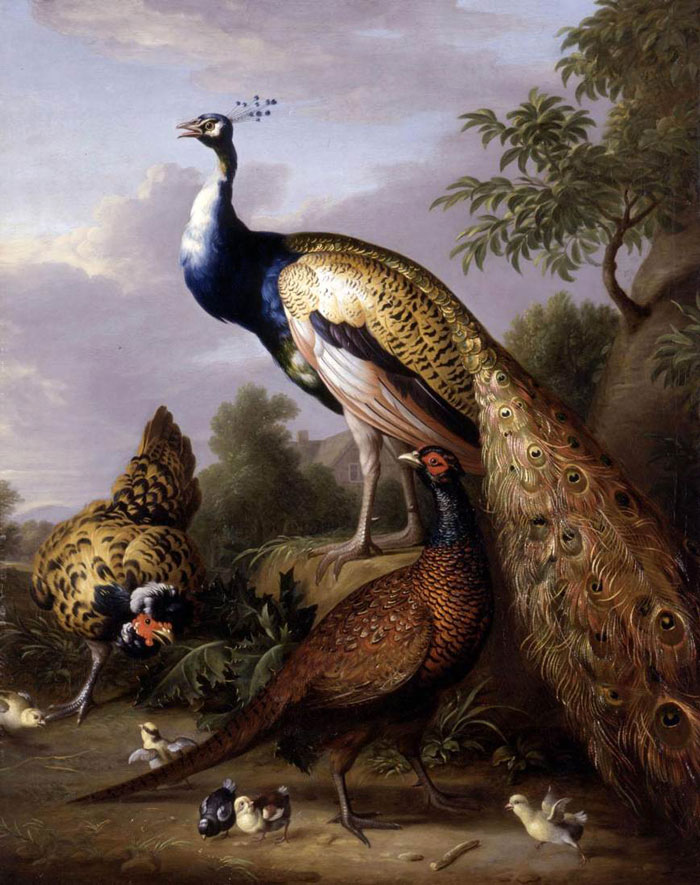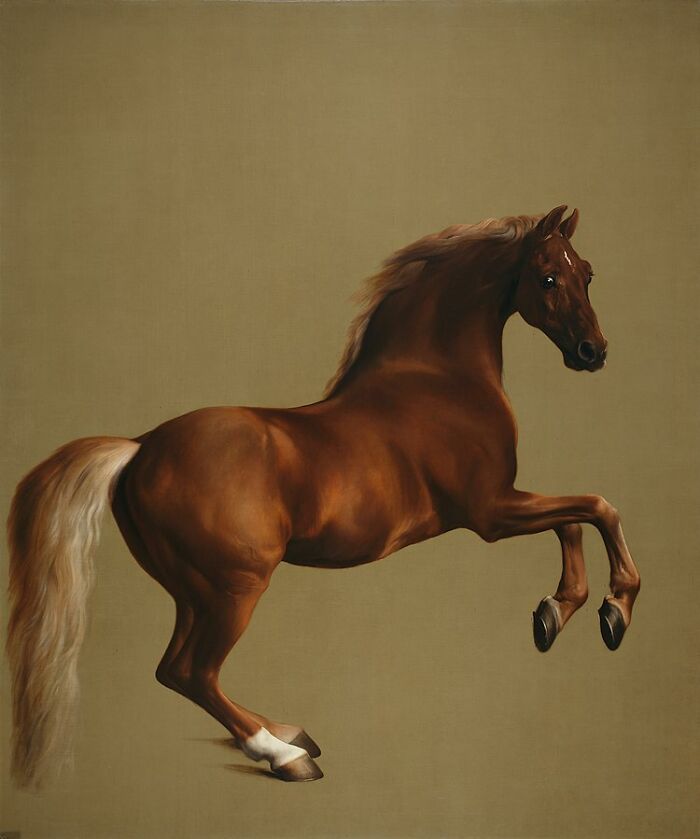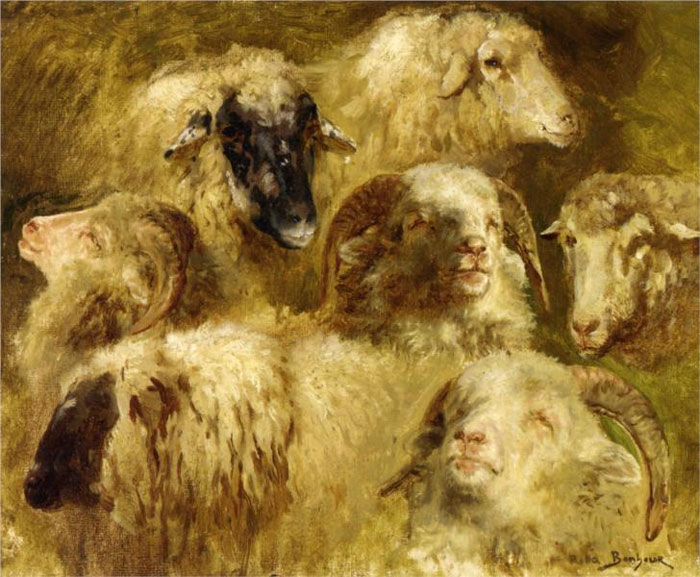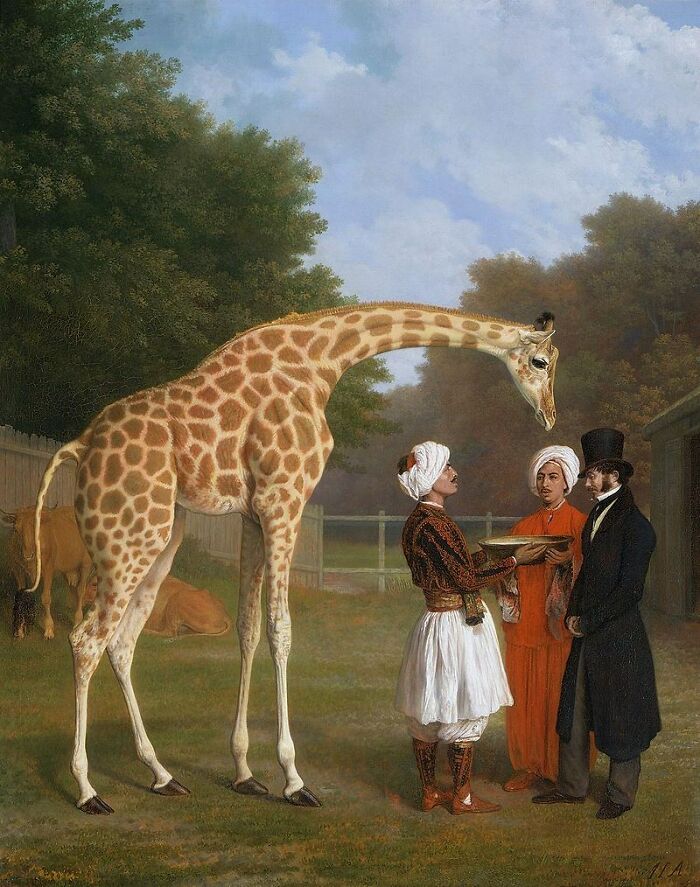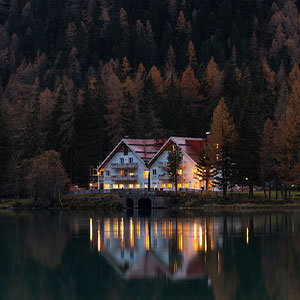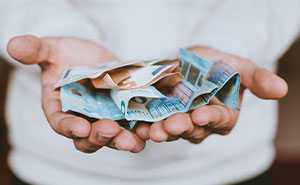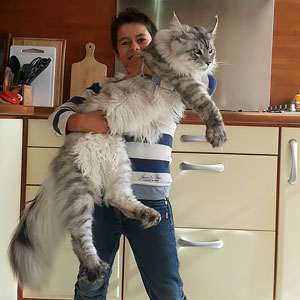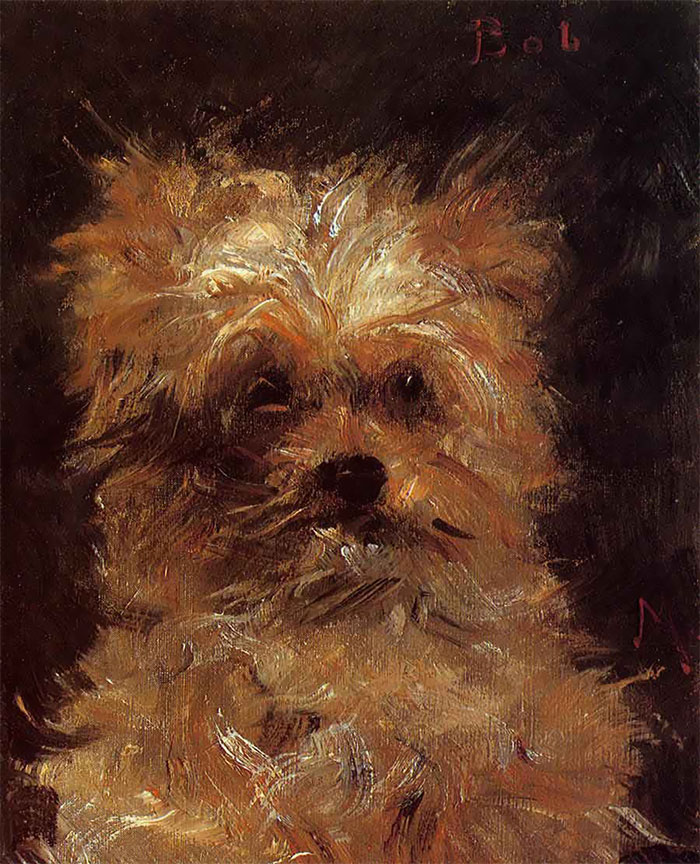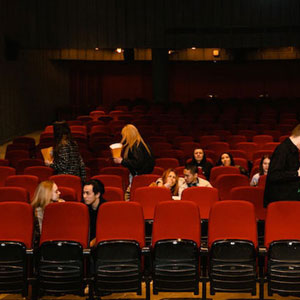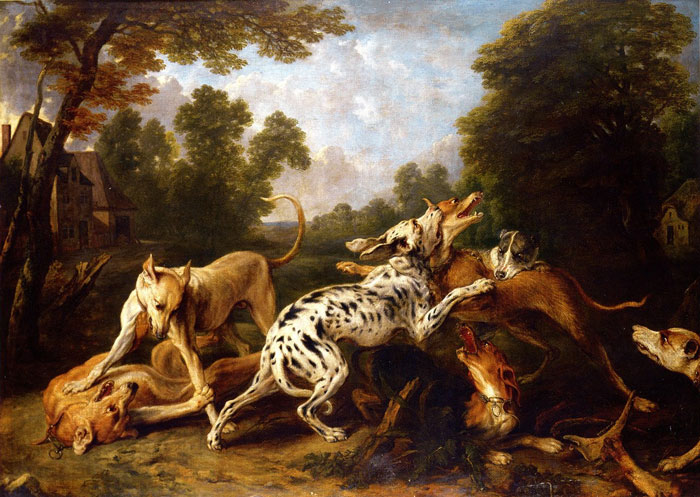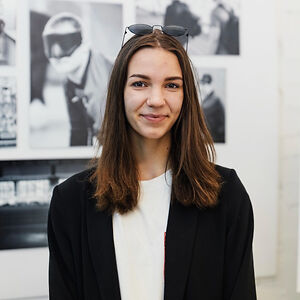We have a soft spot for art. But not just any art — we’re talking about animal paintings. We love animals, we love paintings, and of course, we love the combination of the two!
Following the recent discovery of a pig painting in Indonesia, where Ice Age cave painters flourished, it’s said that the first traces of animals in art date back to at least 45,000 years ago. Since then, art featuring animals has taken many forms. From Pisanello’s Duck in 1440, passing through Yi Am’s art in the 16th century, and the French animal painter Rosa Bonheur in the 1800s, we’ve seen animals depicted in all kinds of styles and genres.
When it comes to capturing the spirit of an animal through pencil or brushstrokes on canvas, some have a talent that is hard to match. We’ve selected our favorite animal artists over time so that you can see how stunning the most famous animal paintings are for yourself! The artists featured here have taken painting animals to the next level — from incredibly realistic portraits of cats and dogs to more abstract pieces that feature animals in new, exciting ways.
This post may include affiliate links.
The Monarch Of The Glen (1851) By Sir Edwin Landseer
Landseer’s The Monarch of the Glen is a stunningly beautiful depiction of a stag — a male deer — now located at the Scottish National Gallery of Edinburgh. The stag is portrayed as majestic, with his antlers raised high as he wanders across a foggy forest glen. It was commissioned in the 19th century as one of three panels to hang in the Palace of Westminster, London.
The Bachelor Party (1896) By Louis Wain
Louis Wain was a shy and eccentric artist from England, best known for his paintings of anthropomorphized cats. The Bachelor Party is a delightful piece that shows a group of five cats enjoying a night out, drinking and smoking cigars. It’s part of a private collection.
Young Hare (1502) By Albrecht Durer
Young Hare is a fascinating example of Dürer’s use of watercolor and his studies on nature and animals. The animal is rendered with almost photographic accuracy, and despite the work’s title, the portrait is sufficiently detailed for the animal to be identified as an adult hare.
Sleeping Dog (1650) By Gerrit Dou
Inspired by the work of Rembrandt, Gerrit Dou painted this incredibly realistic portrait of a sleeping dog. For centuries, the painting has received wide acclaim, and it’s still one of the most popular pieces at the Boston Museum of Fine Arts.
Shepherdess With Her Flock (1864–1865) By Jean-Francois Millet
Shepherdess With Her Flock, exhibited at the Paris Salon of 1864 to great acclaim, features a youthful shepherdess (probably Millet’s daughter) standing alone in a field, surrounded only by her flock of sheep, in a personal moment of tranquility. The painting conveys a sense of peace as well as an underlying feeling of melancholy.
Portrait Of A Lion (1879) By Rosa Bonheur
During the Franco-Prussian War, Rosa Bonheur developed a special fondness for lions and how their image can be associated with freedom, rebellion, and bravery. Anna Klumpke, Bonheur’s partner in the final years of her life, said that Rosa Bonheur was always attracted to the energy of felines, which she began studying at fairs.
What is the substance floating around the lion's head? It looks like shed fur?
Morning In A Pine Forest (1889) By Ivan Shishkin And Konstantin Savitsky
Morning in a Pine Forest depicts a coniferous forest composed of evergreen trees with a family of bears, a mother and her three cubs, playing on a broken pine tree. It’s believed that Shishkin painted the pine trees, inspired by the forests of the Gorodomlya islands, while the bears are attributed to Savitsky.
Naughty Boy Or Compulsory Education (1840-1920) By Briton Rivière
British artist Briton Rivière displayed a variety of artworks at the Royal Academy but committed his life to painting animals.
School Rules (1887) By William Holbrook Beard
William Holbrook Beard made a living out of his satirical paintings of animals performing human-like activities. School Rules presents a group of animal children at school standing in front of their ape schoolmaster.
The Rhinoceros (1515) By Albrecht Dürer
Dürer’s woodcut of a rhinoceros is remarkable, considering the German artist never actually saw one in real life. The image he realized is based on a written description and an anonymous brief sketch of an Indian rhinoceros. Its rhinoceros is not anatomically accurate in every part, but the resemblance to a real one is evident and was copied multiple times in the following centuries.
rly accurate considering the time period it was made in wasnt known for being shockingly lifelike
Peacock, Hen, And Male Pheasant In A Landscape (C. 1750s) By Tobias Stranover
Tobias Stranover, a Transylvanian Saxon painter, had a freshness and exoticism missing from other animal painters active in Britain at the time. It shows in his Peacock, Hen And Male Pheasant In A Landscape, realized in the first half of the 18th century. Very little is known about this oil painting, which is part of a private collection.
The Lady With An Ermine (1489) By Leonardo Da Vinci
One of Leonardo Da Vinci’s most remarkable paintings, The Lady With An Ermine depicts Cecilia Gallerani, the young mistress of Ludovico Sforza, Duke of Milan. Some have noted how the animal in her arms is too large to be an ermine. Still, Da Vinci wanted to pinpoint its symbolic nature more than anatomical accuracy — the ermine is a traditional symbol of purity and moderation.
Zebra (1763) By George Stubbs
Zebra is one of the first works of a series of paintings Stubbs dedicated to exotic animals. The animal in this painting belonged to Queen Charlotte and was the sole survivor of a pair of zebras brought back from Africa by Sir Thomas Adams.
A Distinguished Member Of The Humane Society (1831) By Sir Edwin Henry Landseer
The animal in the picture is meant to be “Bob,” a dog found in a shipwreck near the coast of England who became known for saving many people from drowning. It’s said Landseer bribed the dog with treats to get him to stay still for the portrait. The original painting was damaged in a flood and returned only 50 years after its restoration in 2009.
Whistlejacket (1762) By George Stubbs
British artist George Stubbs was a specialist equine painter, and Whistlejacket is an eloquent example. The painting shows a racehorse, which belonged to the Marquess of Rockingham, rearing up against a plain background. The canvas is empty except for some feeble shadows, with the artist focusing almost entirely on the horse’s appearance and the animal’s incredible details.
It is easy to understand why someone wanted af picture of this magnificent horse.
Victory Or Defeat By Hu Zaobin
A fine representation of animal painting in Chinese art, Victory Or Defeat was realized by Hu Zaobin, a 20th-century painter famous for his portrayal of tigers, who perfected his craft both in his native China and in Japan.
A Family Of Pugs (1877) By Charles Burton Barber
A painting depicting a group of pugs playing and relaxing, A Family of Pugs was commissioned by Queen Victoria at the Windsor kennels. The pugs portrayed here were called Topsy, Sally, Scamp, Quiz, Minnie, May, and then there’s the male puppy of Quiz and Minnie.
Look at those noses. No comparison to the flat ones nowadays that won't let them breathe.
Queen Victoria With John Brown (1876) By Charles Burton Barber
We’ve already talked about how Charles Burton Barber was mainly known for his charming paintings of children and pets, but this one strays away from his usual subjects. It was commissioned by Queen Victoria as a gift to one of her most loyal and faithful servants. It was painted in 1876 and gifted to Brown to celebrate his birthday in August.
The Horse Fair (1852) By Rosa Bonheur
Widely viewed as the most prominent female painter of the 19th century, Rosa Bonheur is an emblematic figure among animaliers. The Horse Fair is one of her most representative works, realized in 1852 and completed with the final details in 1855, and depicts horse dealers at the market on the Boulevard de l’Hôpital, Paris.
A Friend In Need (1903) By C. M. Coolidge
Dogs playing poker and drinking whisky in perfect kitsch style? That’s Cassius Marcellus Coolidge for you. Despite the peculiar subject, A Friend In Need has become one of the most famous animal oil paintings, a recognizable piece that cheekily mirrors the success of middle-class Americans.
Heads Of Ewes And Rams By Rosa Bonheur
Bonheur began her artistic training by studying and sketching domesticated animals, including sheep, which she represented in this artwork.
Gloucestershire Old Spot (1800-1805) By James Ward
Deemed one of the distinguished animal painters of his time, James Ward is the author of Gloucestershire Old Spot, which represents a huge pig in a rural landscape.
Mares And Foals Without A Background (1762) By George Stubbs
George Stubbs’ work was influenced by naturalism, which encouraged painters to represent subjects more accurately, and his series of horse paintings clearly indicate this. It’s believed that George Stubbs used this painting with no background as inspiration for his Mares And Foals In A River Landscape.
Le Chat Blanc (1894) By Pierre Bonnard
Pierre Bonnard’s work heavily features cats, whether as a simple detail in the background or as the central subject, like in Le Chat Blanc. Here Bonnard used distortion to create a comical image of a white cat arching its back. The cat appears disproportionately curved on its long legs, head tucked back, eyes slit, and expression cunning.
probably looks like this because they couldnt get a referance, ever tried to get a cat to stay still? bloody impossible
Tiger In A Tropical Storm (1891) By Henri Rousseau
Tiger In A Tropical Storm is the first jungle painting Henri Rousseau produced. A remarkable aspect of this series is that the locations are entirely imaginary: Rousseau never left France, nor did he see what a real jungle looked like. It’s not quite clear if the tiger is getting ready to jump on its prey or simply cowering from the flash of lightning in the midst of a raging gale.
Wondrous Birds (1892) By Hans Thoma
Hans Thoma created several paintings of flying storks, including Wondrous Birds, which shows the storks from the perspective of another bird. This point of view makes it look like the viewer is in the sky too, flying beside the birds. Thoma’s decision to paint storks may have been influenced by his interest in German folklore, where storks are said to bring fortune to families.
Especially impressive because the only to imagine an aerial view like that in those days would be to view it from a hot air balloon.
Alligators (1917) By John Singer Sargent
Watercolor represented a vital aspect of Sargent’s works, and he frequently looked to it as a way to personal expression. This painting of alligators appears to have been abandoned and was probably used to prepare for another work, Muddy Alligators.
The Yellow Cow (1911) By Franz Marc
Franz Marc’s The Yellow Cow, a color the artist associated with femininity and sensuality, is an expressionist take on animals in art. A remarkable aspect of the painting is the stark contrast between the dynamic subject and the background, which looks calmer, almost still. It’s located at the Guggenheim, New York.
I love this artists paintings, theyre so colourful! I like the blue fox best
The Nubian Giraffe (1827) By Jacques-Laurent Agasse
This giraffe was sent to George IV as a gift from Mehmet Ali, Pasha of Egypt, in 1827. The animal died only two years later. Agasse’s work is a portrait of the noble animal in captivity, with his keepers trying to persuade him to drink. The fact his long neck is so bent is a symbol of his poor condition.
Two Owls Fighting Over A Rat (1713) By Hans Georg Müller
Hans Georg Müller was born in Germany and immigrated to Sweden. He was a painter who also worked as a drawing instructor. Among his students, we find Carl Gustaf Tessin, an art collector who owned this painting for a long time. Two Owls Fighting Over A Rat is a lively depiction of two owls, active in the night hours, trying to steal dead prey from one another.
The Entry Of The Animals Into Noah's Ark (1613) By Jan Brueghel The Elder
An animal painting with religious undertones, it reproduces the story of Noah and how God instructed him to build an ark and save a male and female of every animal species. The exploration of the Americas in the 1500s led to an increased interest in animals and nature. By the time Brueghel started this painting, many animals from the new continent were already familiar enough to European artists to be painted with precision.
Hound Coursing A Stag (1762) George Stubbs
Despite Stubbs’s success coming primarily from his paintings of horses, the British artist also had a knack for capturing the beauty of other animals, like dogs and exotic animals. Hound Coursing A Stag is on display at the Philadelphia Museum of Art.
Napoleon Crossing The Alps (1800) By Jacques-Louis David
Among the most commonly reproduced representations of Napoleon, the name actually refers to a series of five paintings initially commissioned by the King of Spain. Like many equestrian portraits, a genre favored by royalty, Napoleon Crossing The Alps is a portrait of authority. It is considered pure propaganda instead of art by many, with Bonaparte specifically asking Jacques-Louis David to portray him as “calm, mounted on a fiery steed.”
First time I've ever noticed the army behind him, the image of him on the horse is so dynamic.
Cat Among Roosters (1706–1710) By Jacob Bogdani
Jakob Bogdány was a Hungarian artist well known for his depictions of birds. Cat Among Roosters illustrates a typical animal scene of the Baroque period, especially in Dutch art of the 17th century. The painting is rich with realistic details that bring into sharp focus the struggle for life of a chick attacked by a cat.
Lioness Reclining (1855) By Eugene Delacroix
Lioness Reclining is an example of animal painting in the Romanticism style, realized by Eugène Delacroix in 1855.
A Little Girl And Her Sheltie (1892) By Charles Burton Barber
Charles Burton Barber was a British painter who gained recognition for painting children and their pets. He was regarded as one of Britain’s finest animal painters and received commissions for 25 years from Queen Victoria herself to portray her with her grandchildren and dogs.
A Horse Frightened By A Lion (1770) By George Stubbs
Around 1762, George Stubbs started working on a series of paintings on the subject of a lion attacking a horse, which he kept reinterpreting over a span of 30 years. With no surprise, they ended up becoming part of his most celebrated and influential works. This one, completed in 1770, shows a white horse terrified in dramatic tension at the sight of a lion.
The Turkeys (1877) By Claude Monet
Claude Monet’s painting shows a flock of turkeys wandering at the Chateau of Rottenburg in Montgeron. It’s part of a series of four decorative panels commissioned by Ernest Hoschedé, owner of the estate, who critics thought wanted to use the panels to represent the estate during the four seasons.
Mogyeon (16th Century) By Yi Am
Mogyeon, also known as Mother Dog And Puppies, was realized by Yi Am, one of Korea’s most influential animal painters. Active during the Joseon dynasty, Yi Am developed his own personal style, gradually moving away from the traditional Chinese school of painting. The scene depicted here is entirely focused on this warm moment, with the puppies visibly relaxed, comforted by their mother’s presence.
Monkeys In A Tavern (1660) By David Teniers The Younger
David Teniers the Younger was an incredibly versatile artist who focused part of his work on depicting taverns. Monkeys In A Tavern might feel a little out of place, but it’s actually part of an artistic movement with monkeys as the central subjects. Monkeys in art were incredibly popular in the 16th and 17th centuries and were often included in humorous scenes.
Lamb Of God (1635-40) By Francisco De Zurbaran
It’s no surprise that lambs carry a symbolic meaning in religious paintings. Francisco De Zurbaran’s lamb is depicted bound in a sacrificial posture, symbolizing Christ’s sacrifice for the salvation of the world. It’s housed in the Prado Museum in Madrid, Spain.
Snowy Heron Or White Egret (1835) By John James Audubon
John James Audubon was a naturalist painter with a mission: to make a complete illustrated record of all the bird species in North America. He was renowned for his extensive studies and detailed illustrations, and some of the scientific names he published are still in use by the scientific community today. The one depicted here is a beautiful species found in Florida and Louisiana.
The Goldfinch (1654) By Carel Fabritius
Painted by Carel Fabritius, an exponent of the Dutch Golden Age, The Goldfinch is now part of the Mauritshuis collection in The Hague, Netherlands. The painting depicts a life-size European goldfinch, a colorful species believed to bring health and good fortune.
The Kongouro From New Holland (1772) By George Stubbs
George Stubbs gifted us with the first depictions of Australian animals in European art. With no live subject to use as inspiration, he based his work on a drawing plus a sample of kangaroo skin collected during James Cook’s first voyage. The painting is displayed at the National Maritime Museum of Greenwich, London.
Lying Cow (1883) By Vincent Van Gogh
Among Vincent Van Gogh’s early works, we find the Lying Cow, a black and white bovine lying down in a green meadow facing the viewer. The Dutch artist painted it around 1882 when he lived in The Hague.
A King Charles Spaniel (C. 1866) By Edouard Manet
Édouard Manet was a major figure in the shift from Realism to Impressionism. Not much is known about this work or Manet’s animal paintings. Still, according to some associate curators, he painted portraits of pets for his friends and other people in his inner circle. It’s on display at the National Gallery of Art in Washington, D.C.
Head Of A Dog (1876) By Edouard Manet
The portrait of this dog, which Manet named Bob, was painted in the artist’s hometown in 1876. Said to be realized in both realist and impressionist styles, it clearly shows the loose, textured brushstrokes typical of Manet’s style.
Ducks (C. 1880-1904) By Willem Maris
Born and raised in The Hague, Willem Maris stuck to the same natural and animal subjects his whole life: meadows, ditches, ponds, cows, chickens, and as displayed in this canvas, ducks. The painting is currently located at the Rijksmuseum, Amsterdam.
Cat And Bird (1928) By Paul Klee
Paul Klee was notoriously fascinated by cats and how children create art with their own personal views on the world. Cat And Bird combines these interests and, despite the tension you can expect when a cat and a bird meet, the warm colors and softness make it much quieter and more dreamlike.
Still Life With Dead Game In A Marble Niche (1706) By Alexandre-François Desportes
Trained as an animal painter and favored by both Louis XIV and Louis XV, Alexandre-François Desportes gained recognition for his hunting scenes as well as his magnificent still lifes.
Swan Attacked By A Dog (1745) By Jean-Baptiste Oudry
18th-century critics interpreted Oudry’s animal paintings as historical subjects and judged them as they would with scenes of human emotion. Oudry was also highly respected back in his day for his tremendous skills in handling white-on-white areas, such as the feathers of this swan, which show a superb range of shades and tones.
Landscape With Exotic Birds And Two Dogs (1724) By Jakob Bogdány
Jakob Bogdány’s bird paintings often feature a variety of exotic species, like cockatoos, macaws, and mynas, imported to Europe at the time. The artist often used a bird of red plumage, such as a scarlet ibis, red avadavat, or northern cardinal, to highlight his paintings.
A Good Shot (1892) By Winslow Homer
A Good Shot is Homer’s only watercolor to show a deer’s death. This piece captures a specific moment in time, the instant a stag has been shot while climbing to the top of a rock in a river. On the right are two hounds running in the direction of the mortally wounded animal.
Outing (1885) By Philip R. Goodwin
Goodwin was a skilled painter who provided illustrations for numerous books and magazines, especially depictions of wildlife and outdoor scenes. This artwork of a standing bear was included in the book Outing, published in 1885.
Off To School (1883) By Charles Burton Barber
Barber’s talent made him a highly sought-after artist, and in 1883, the year Off To School was painted, he was elected a member of the Royal Institute of Painters. In this piece, we find a young noble girl with her St. Bernard as he follows her to school. The dog stands in a regal posture, and his size gives off a feeling of security.
Bull (1911) By Franz Marc
Franz Marc’s depiction of a bull seems inspired by the Pinzgauer, a breed native to Austria. The artist has depicted such a strong animal to seem fragile and vulnerable, endearing it to the viewer. The care taken by Marc in his portrayal of the bull proves his love for the natural and animal worlds, the main subjects of his art.
Fox Hunt (1893) By Winslow Homer
Winslow Homer began to depict naturalist subjects in 1890, such as scenes of hunting and fishing or coastal and marine views. Fox Hunt, the largest single canvas realized by Homer, narrates a story of brutal reality, with a fox desperately trying to escape from a flock of crows driven by hunger.
Deer In The Forest (1913) By Franz Marc
Franz Marc painted his Deer In The Forest in 1913 when he wanted to escape the political tension in Germany by immersing himself in the purity of the animal kingdom. This wildlife painting depicts a group of deer nestled in a forest. Just above their heads, there’s a giant flying bird, thought to symbolize the looming threat of war in Germany.
Allegory Of War (C. 1640s) By Jan Brueghel The Younger
Jan Brueghel the Younger’s repertoire is no stranger to history paintings and allegorical scenes. Realized in the 1640s, near the end of Europe’s Thirty Years’ War, he summarizes all the horrors of one of the most destructive conflicts in European history through the image of the weapons, the animals fighting each other, and the burning city.
Donkey Frieze (1911) By Franz Marc
Part of a private collection, Franz Marc uses Donkey Frieze to represent the deleterious tiredness and fatigue caused by a life of hard work. The concept is highlighted by the color blue, often associated with sadness, and the weary expressions on the donkeys’ faces, perfectly catching the emotion of exhaustion even if the subjects are non-human.
Animal Study (17th Century) By Nicolaes Berchem
Nicolaes Berchem was one of the most prolific artists of the Dutch Golden Age with his pastoral landscapes and mythological and biblical references. This is one of the most notable examples of Berchem’s animal studies. It’s currently located at the Museum voor Schone Kunsten in Ghent, Belgium.
The Sleeping Gypsy (1897) By Henri Rousseau
Rousseau first displayed this painting at the 13th Salon des Indépendants. He described this piece as representing a wandering mandolin player lying on the ground, exhausted and fast asleep. A lion approaches her but doesn’t hurt the woman. He stands there under the moonlit light, which gives the painting a poetic effect.
Duck (1440) By Pisanello
Pisanello’s drawings, prized as jewels of the Quattrocento, depict the elegant garb of the time. His studies and drawings of animals are famous and considered among the best of his time, anticipating the fine animal art of Leonardo Da Vinci and Albrecht Dürer. Unlike his contemporaries, Pisanello’s drawings were not preliminary sketches for future paintings but stand-alone works of art.
Hunting Dogs In A Boat (1889) By Winslow Homer
Five dogs are crowded into a boat, waiting for the next command or perhaps just resting after a day spent hunting deer. This painting demonstrates the full maturity of Winslow Homer’s technical skills, which set him apart as a preeminent figure in American art.
Le Chat Tigre By Henri Rousseau
It’s not clear when Henri Rousseau realized Le Chat Tigre, but it’s estimated it could have been around 1863, when the artist was barely more than a teenager. The perspective is not quite right, and the cat is strangely proportioned, but these inaccuracies are considered deliberate to help add a sense of charm to the animal.
it may not look like a cat, but it captures the energy they give of spectacularly
Sitting Dog On Pillow (1855) By Gustave Courbet
Gustave Courbet, author of some of the most controversial paintings in history — The Origin Of The World and Two Nude Women are the most notable examples — also had a thing for portraying dogs. Painted in 1855, Sitting Dog On Pillow is a lesser-known work, but it still showcases why he’s considered the father of French realism.
The Parade (1866) By Edgar Degas
Horse racing, a sport from England, was a novelty then. Degas started using racetracks as a subject for his art in the early 1860s. However, he rarely painted the course itself. Instead, he was fascinated by what had happened before: the preparations, the false starts, the wait, the tension — all moments that usually lack action.
Right And Left (1909) By Winslow Homer
Realized just one year before Homer’s death, Right And Left depicts two ducks at the exact moment they’re shot by a hunter. The title refers to the act of shooting ducks successively with separate barrels of a shotgun.
Dogs Fighting (17th Century) By Frans Snyders
Frans Snyders dedicated his life to depicting animals in everyday environments, especially hunting scenes, and he’s credited with initiating new still-life and animal subjects in Antwerp. Dogs Fighting is currently part of a private collection in Spain.
Head Of A Dog (1930) By Edvard Munch
Head Of A Dog, by Norwegian artist Edvard Munch, is one of the artist’s most famous animal paintings. In his later years, spent working in peace and privacy, he developed a close relationship with his dogs, which gave him comfort and became the subject of a series of works. The painting is on display at the Munch Museum in Oslo, Norway.












